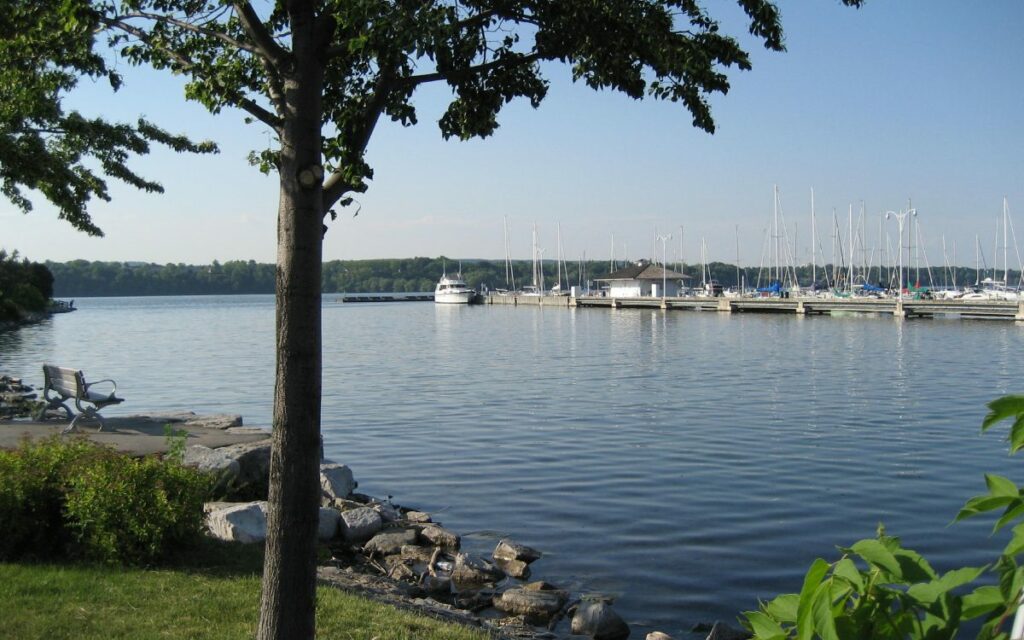
Anyone who has been in direct contact with the water at Pier 4 and is experiencing any of those symptoms is advised to contact their primary care provider. Pictured: Pier 4 Park.
The beach at Hamilton’s Pier 4 Park, located at the end of Bay Street North, is closed due to the presence of “toxin-producing blue-green algae (cyanobacteria),” according to the city.
There are signs at the beach that inform the public that the site is “closed” to all water recreational activities.
The city says that the closure is in effect “until the blue-green algae subsides.”
Officials warn that visitors to the park should avoid all contact with the water at the Pier 4 Park beach, including while launching and trailering watercraft.
Those who do come in contract with the water are told to wash themselves off with clean water as soon as possible.
People are also warned not to swim or wade in the area or allow their pets to come in contact with the water.
Nevertheless, the city says that “adverse health effects” are mainly only caused by drinking water that is contaminated with blue-green algae toxins.
Symptoms associated with contacting or ingesting the contaminated water include headaches, skin irritation, rash, sore throat, sore red eyes, swollen lips, fever, nausea and vomiting, and/or diarrhea.
Anyone who has been in direct contact with the water at Pier 4 and is experiencing any of those symptoms is advised to contact their primary care provider.
The city says that blue-green algae forms in shallow, warm, slow-moving or still waters and can be caused by increases in water temperature, high nutrient loads, and water mixing.
Officials say that the vegetation in the water can also give off a strong odour as it decays and that algae blooms have been observed until late December.
In the meantime, Hamilton Public Health Services continues to monitor and gather water samples from local beaches.
Public Health monitors beaches annually from the end of May until the end of August.
Updates are posted regularly at www.hamilton.ca/beaches
Hamilton Public Health also monitors recreational water quality at public beaches for levels of E. coli bacteria.
High numbers of E. coli in the water at public beaches indicates contamination with feces and the potential presence of other harmful microorganisms in the water.
The provincial standard is 200 E. coli bacteria cells per 100 ml of water, with concentrations higher than that number likely to cause infections in ears, eyes, nose, throat, and skin as well as cause diarrhea if the water is ingested.
According to tests done on Aug. 12, 2024, Valens Conservation Area is unsafe for swimming, as the E. coli Geometric Mean was tested at 276.
However, Christie Conservation Area, Beach Boulevard, Van Wagner’s Beach, and Confederation Park Beach have all tested safe for swimming, according to tests done the same day.
Christie tested at 21 bacteria cells, Beach Boulevard at 13, Van Wagner’s at 26, and Confederation Park at 15.
But another Hamilton beach, the one at Binbrook Conservation Area, is listed as unsafe for swimming on the city website.
While the City of Hamilton site does not list the reason why, a website called The Swim Guide managed by Swim Drink Fish Canada states that the conservation area also has blue-green algae.

Based in Hamilton, he reaches hundreds of thousands of people monthly on Facebook, Instagram, TikTok, and Twitter. He has been published in The Hamilton Spectator, Stoney Creek News, and Bay Observer. He has also been a segment host with Cable 14 Hamilton. In 2017, he received the Chancellor Full Tuition Scholarship from the University of Ottawa (BA, 2022). He has also received the Governor General’s Academic Medal. He formerly worked in a non-partisan role on Parliament Hill in Ottawa.






